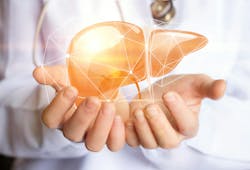A case for alanine transaminase (ALT) testing
Perhaps the most underappreciated organ in the human body is the liver. It is one of the largest organs in the body, and unlike other vital organs such as the skin and kidneys, the liver has a myriad of functions. When the liver is compromised, its functions are also impeded. This results in many symptoms, and in some cases, the patient remains asymptomatic.
The liver weighs approximately 1.4–1.5 kilogram (kg) in males and 1.2–1.4 kg in females. It has an approximate length of 15–18 centimeters (cm), 10–12 cm width, and 5–8 cm in thickness. The liver increases 5 cm every 5 years as a child gets older and thus attains a size of 15 cm by age 15.9 Three-quarters of the liver is situated in the upper right quadrant with a thickness of 2.3 cm. The left lobe is in the upper left quadrant and is 1.2 cm thick. The right lobe extends further down than the left lobe, misaligning the left and right kidneys. However, several factors influence the exact liver measurements. Research using ultrasound showed that age, sex, body shape, and size are the critical determinants of liver size. In general, the liver is larger in males than in females.1 Examination techniques, whether palpation, percussion, or radiographic, may influence the reported measurements.9 Visually, the liver is shiny and has a burgundy color. It has a smooth texture upon touch, showing its delicacy and vulnerability. Most of the liver is protected by the rib cage, and this may pose a challenge to physical examination.
Function
The human body is an ecosystem in which many processes take place simultaneously to maintain a homeostatic balance. Organs function to sustain the life of an organism. Many of these organs, even though vital, have limited functions compared to the liver. For example, the major function of the heart is to pump blood, the lungs for gas exchange, the kidneys for water regulation, and so forth. The liver, on the other hand, is said to have over 500 functions that include hematopoiesis, nutrient storage, metabolism, digestion, gluconeogenesis, clotting factors production, detoxification, and many other functions.
When the liver is compromised, many other processes throughout the body are affected. It is, therefore, critical to evaluate the health of the liver at certain intervals depending on a person’s genetic predisposition, age, sex, and susceptibility to occupational exposure. Clinical laboratories perform several tests that aid in the diagnosis of liver complications.
Liver tests
One of the most common tests for liver disease disorders is a liver profile. The profile, often called the panel, is a group of tests ordered together to provide a comprehensive status of an organ or a process. The liver profile is a panel that includes four main enzyme tests that indicate a liver disorder. A liver test, such as aspartate aminotransferase (AST), also known as serum glutamic-oxaloacetic transaminase (SGOT), is a common enzyme used to detect liver anomalies. The challenge is that this enzyme is also found in the heart and muscles. Its elevation in laboratory testing cannot be solely attributed to liver problems.
Another common liver enzyme test, alkaline phosphatase (ALP), plays a role in metabolism. The enzyme, although present in the liver, is also found in various tissues that include the intestines, kidneys, and bones. Gamma glutamyl transferase (GGT) is found primarily in the liver, where it is implicated in liver functions and bile production. Although it is used to monitor liver disease or damage, it cannot be used for the diagnosis of liver disease without other tests to confirm the diagnosis. GGT can also be used to monitor the treatment of liver conditions. Perhaps one unique characteristic of the liver is that it is the only organ in a human that has the ability to regenerate. However, Forbes and Newsome2 reported that conditions such as chronic scarring, fatty liver disease, massive liver injury, and prior exposure to chemotherapy can impede regeneration, leading to liver failure.
Alanine aminotransferase
Alanine aminotransferase (ALT), also referred to as serum glutamic-pyruvic transaminase (SGPT), completes a list of liver tests for the evaluation of liver disorders. ALT may be in other organs, such as in heart, kidney, and muscle cells; it remains an indicator of definite liver cell injury.7 ALT is a reliable and sensitive marker for liver disease.5 Concentration of ALT in the liver is 3000 times that of the blood,8 making it an ideal marker for liver-related diseases and disorders. The elevation of ALT is the first sign of liver problems, and it triggers a workup to determine the underlying disease.
ALT stays elevated in diseases such as cardiovascular disease, diabetes, and obesity.6 Other diseases associated with elevated ALT include viral hepatitis, non-alcoholic fatty liver disease, as well as acute and chronic liver diseases.10 ALT can be detected in serum at low concentrations. The amount increases with injury to the hepatocyte membrane. The amount of alanine is determined by a number of factors, including age, sex, body mass index, pubertal age, and elevated levels of triglycerides.7 Researchers also reported other physiological factors that affect ALT levels. Excessive physical exertion, ethnicity, body mass index, and diurnal variation have been associated with different levels of ALT.7
Detection of ALT
Several instruments use different methods to quantify the amount of ALT in serum or whole blood. Even though these testing methods are built into different instruments, manufacturers are concerned about the accuracy of measurement. The spectrophotometric method to quantify ALT in serum is quite popular in a clinical laboratory. Serum ALT acts on L-alanine and α-ketoglutaric acid. The reaction results in the production of L-glutamate and pyruvate. Lactate dehydrogenase catalyzes the reduction of pyruvate by NADH to lactic acid. This reaction oxidizes NADH (nicotinamide adenine dinucleotide) to produce NAD+. The rate of the NADH oxidation reaction is measured as a decrease in absorbance at 340 nanometers (nm) when using a spectrophotometer. This decrease in absorbance is directly proportional to the concentration of ALT.4
The Colorimetric method was also popular in quantifying serum ALT but was replaced by the spectrophotometric method. In this method, ALT acts on L-alanine and α-ketoglutaric acid to produce L-glutamate and pyruvate. Pyruvate then reacts with a colored agent to form a hydrazone, which has a distinct color. The intensity of the color is proportional to the concentration of ALT and is measured by a colorimeter. Several other methods are used to measure levels of ALT. Chemiluminescence is based on enzyme coupling that results in the production of hydrogen peroxide. The produced hydrogen peroxide reacts with a chemiluminescent to produce a light signal. The light signal is measured to determine ALT levels in whole blood or serum. Fluorescence and chromatography are just some of the methods used in the laboratory.3
Conclusion
Alanine aminotransferase (ALT) is an important indicator for liver disease or disorder. Although AST, ALP, ACP (acid phosphatase), and LD (lactate dehydrogenase) may be included in the liver panel, ALT remains the most reliable indicator of liver disease. Even though ALT is found in several organs and tissues, the highest concentration is found in the liver. The reference range for ALT is affected by many factors that include physical exertion, age, ethnicity, and body mass index. There are several methods of testing ALT. The spectrophotometric method, which replaced the colorimetric method, is the most commonly used method in the clinical laboratory.
References
- Choukèr A, Martignoni A, Dugas M, et al. Estimation of liver size for liver transplantation: the impact of age and gender: Role of Age and Gender for Liver Graft Size. Liver Transpl. 2004;10(5):678-685. doi:10.1002/lt.20113.
- Forbes SJ, Newsome PN. Liver regeneration - mechanisms and models to clinical application. Nat Rev Gastroenterol Hepatol. 2016;13(8):473-85. doi:10.1038/nrgastro.2016.97.
- Hartmann P, Schnabl B. Inexpensive, accurate, and stable method to quantitate blood alanine aminotransferase (ALT) levels. Methods Protoc. 2022;5(5):81. doi:10.3390/mps5050081.
- Hsueh CJ, Wang JH, Dai L, Liu CC. Determination of alanine aminotransferase with an electrochemical nano ir-C biosensor for the screening of liver diseases. Biosensors (Basel). 2011;1(3):107-17. doi:10.3390/bios1030107.
- Kaplan MM. Alanine aminotransferase levels: what's normal? Ann Intern Med. 2002;137(1):49-51. doi:10.7326/0003-4819-137-1-200207020-00012.
- Kim WR, Flamm SL, Di Bisceglie AM, Bodenheimer HC; Public Policy Committee of the American Association for the Study of Liver Disease. Serum activity of alanine aminotransferase (ALT) as an indicator of health and disease. Hepatology. 2008;47(4):1363-70. doi:10.1002/hep.22109.
- Moriles KE, Zubair M, Azer SA. Alanine Aminotransferase (ALT) Test. StatPearls [Internet] Treasure Island. Published online 2024.
- Rej R. Aspartate aminotransferase activity and isoenzyme proportions in human liver tissues. Clin Chem. 1978;24(11):1971-9.
- Wolf DC. Evaluation of the size, shape, and consistency of the liver. In: Clinical Methods: The History, Physical, and Laboratory Examinations. Butterworths; 1990.
- Yip TC, Wong VW, Wong GL. Alanine aminotransferase level: The road to normal in 2021. Hepatol Commun. 2021;5(11):1807-1809. doi:10.1002/hep4.1788.
About the Author

Violet Nxedhlana, PhD, MLS(ASCP)
is the Program Director & Associate Professor of the Medical Technology Program at John A. Burns School of Medicine, University of Hawai‘i at Manoa. She oversees the day-to-day operation of the Medical Technology program and is responsible for the overall management, leadership, and accreditation compliance of the educational program. She also designs, reviews, and revises the curriculum to reflect current best practices in medical laboratory science.

Shepherd Maingano, PhD, MLS(ASCP), GCCP
is the Program Director & Associate Professor for Medical Laboratory Technician and Phlebotomy Programs at University of Hawai‘i’s Kapi‘olani Community College. He is responsible for the organization, administration, periodic review, records, continued development, and general policies and effectiveness of the program. He is also a professor of Hematology and Clinical Chemistry.
